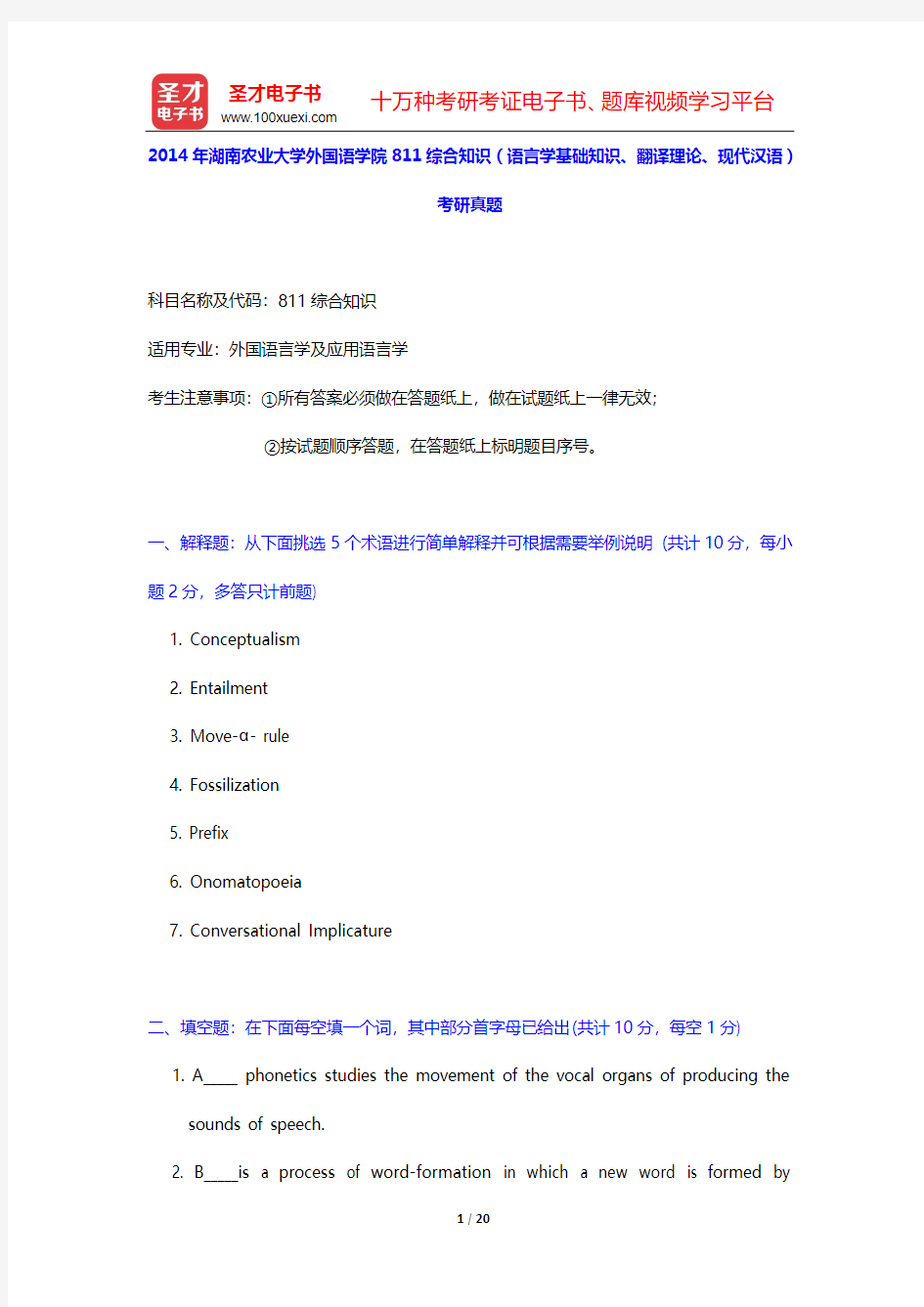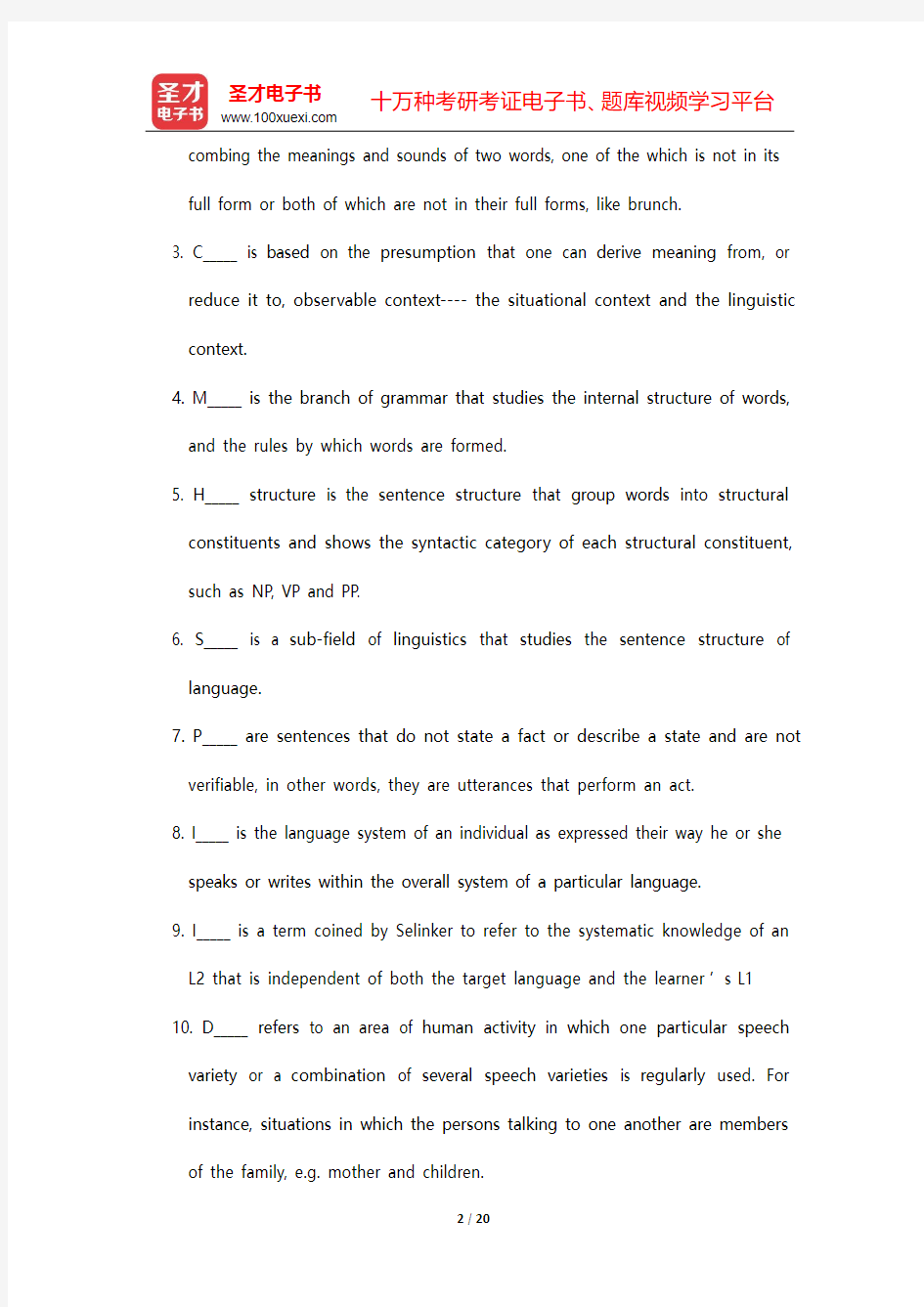2014~2017年湖南农业大学外国语学院811综合知识(语言学基础知识、翻译理论、现代汉语)考研真


2014年湖南农业大学外国语学院811综合知识(语言学基础知识、翻译理论、现代汉语)
考研真题
科目名称及代码:811综合知识
适用专业:外国语言学及应用语言学
考生注意事项:①所有答案必须做在答题纸上,做在试题纸上一律无效;
②按试题顺序答题,在答题纸上标明题目序号。
一、解释题:从下面挑选5个术语进行简单解释并可根据需要举例说明(共计10分,每小题2分,多答只计前题)
1. Conceptualism
2. Entailment
3. Move-α- rule
4. Fossilization
5. Prefix
6. Onomatopoeia
7. Conversational Implicature
二、填空题:在下面每空填一个词,其中部分首字母已给出(共计10分,每空1分)
1. A_____ phonetics studies the movement of the vocal organs of producing the
sounds of speech.
2. B_____is a process of word-formation in which a new word is formed by
combing the meanings and sounds of two words, one of the which is not in its full form or both of which are not in their full forms, like brunch.
3. C_____ is based on the presumption that one can derive meaning from, or reduce it to, observable context---- the situational context and the linguistic context.
4. M_____ is the branch of grammar that studies the internal structure of words, and the rules by which words are formed.
5. H_____ structure is the sentence structure that group words into structural constituents and shows the syntactic category of each structural constituent, such as NP, VP and PP.
6. S_____ is a sub-field of linguistics that studies the sentence structure of language.
7. P_____ are sentences that do not state a fact or describe a state and are not verifiable, in other words, they are utterances that perform an act.
8. I_____ is the language system of an individual as expressed their way he or she speaks or writes within the overall system of a particular language.
9. I_____ is a term coined by Selinker to refer to the systematic knowledge of an L2 that is independent of both the target language and the learner’s L1 10. D_____ refers to an area of human activity in which one particular speech variety or a combination of several speech varieties is regularly used. For instance, situations in which the persons talking to one another are members of the family, e.g. mother and children.
三、判断题:根据语言学常识判明正误,对者标T,错者标F。(共计15分,每小题1.5分)
1. ()Discourse analysis is the study of how sentences in spoken and written
language form larger meaningful units such as paragraphs, conversations,
interviews, etc.
2. ()Vernacular refers to a change by a speaker form one language or
language variety to another, it can take place in a conversation when one
speaker uses one language and the other speaker answers in a different
language.
3. ()Chomsky’s concept of linguistic performance is similar to Saussure’s
concept of parole, while his use of linguistic competence is somewhat different from Saussure’s langue.
4. ()If language learners are provided with sufficient and the right kind of
language exposure and chances to interact with language input, they will
acquire the native-like competence in the target language.
5. ()Syntactic category refers to all phrasal syntactic categories such as
NP,VP, and PP, and word-level syntactic categories that serve as heads of phrasal syntactic categories such as N and V.
6. ()Cohesion shows whether a certain tagmeme is dominating other
tagmemes or is dominated by others.
7. ()Inviting, suggesting, warning, ordering are instances of commissives.
8. ()Hyponymy is a matter of class membership, so it is the same as
meronymy.
9. ()An endocentric construction is also known as a headed construction,
it has just one head.
10. ()We can always tell by the words a compound contains what it means
because the meaning of a compound is always the sum of the meaning of its parts.
四、问答题:从下面各题挑选5题做简单回答(共计20分,每小题4分,多答只计前5题)
1. How to distinguish root, stem and base?
2. What are deep structure and surface structure?
3. What is the difference between synchronic linguistics and diachronic
linguistics?
4. What is stress in a word? For words of more than one syllable, how are they
pronounced?
5. What’s your understanding of cooperative principle?
6. What is predicate analysis? What is a no-place, one-place, two-place, or
three-place predicate?
7. Make a comment on ONE of the following linguists’contribution to
linguistic study: (1) Chomsky’s; (2) Halliday’s; (3) Saussure’s; (4) LüShuxiang’s (吕叔湘); (5) Zhao Yuanren’s (赵元任)
五、英译汉:将下列段落翻译成汉语(共计30分)
(1)
What is leadership?
Its qualities are difficult to define. But they are not so difficult to identify
Leaders don’t force other people to go along with them. They bring them along. Leaders get commitment from others by giving it themselves, by building an environment that encourages creativity, and by operating with honesty and fairness.
Leaders demand much of others, but also give much of themselves. They are Ambitious — not only for themselves, but also for those who work with them. They seek to attract, retain and develop other people to their full abilities.
Good leaders aren’t lone rangers. They recognize that an organization’s strategies for success require the combined talents and efforts of many people. Leadership’s is the catalyst for transforming those talents into results.
Leaders know that when there are two opinions on an issue, one is not bound to be wrong. They recognize that hustle and rush are the allies of superficiality. They are open to new ideas, but they explore their ramifications thoroughly.
(2)
Thomas Malthus first published his “Essay on the Principle of Population”, in which he forecast that population growth would outstrip the world’s food supply, in 1798. His timing was unfortunate, for something started happening around then which made nonsense of his ideas. As industrialization swept through what is now
the developed world, fertility fell sharply, first in France, then in Britain, then throughout Europe and America. When people got richer, families got smaller; and as families got smaller, people got richer.
Now, something similar is happening in developing countries. Fertility is falling and families are shrinking in places—such as Brazil, Indonesia, and even parts of India—that people think of as teeming with children. As our briefing shows, the fertility rate of half the world is now 2.1 or less—the magic number that is consistent with a stable population and is usually called “the replacement rate of fertility”. Sometime between 2020 and 2050 the world’s fertility rate will fall below the global replacement rate.
Falling fertility is a boon for what it makes possible, which is economic growth. Demography used to be thought of as neutral for growth. But that was because, until the 1990s, there were few developing countries with records of declining fertility and rising incomes. Now there are dozens and they show that as countries move from large families and poverty into wealth and ageing they pass through a Goldilocks period: a generation or two in which fertility is neither too high nor too low and in which there are few dependent children, few dependent grandparents—and a bulge of adults in the middle who, if conditions are right, make the factories hum. For countries in demographic transition, the fall to replacement fertility is a unique and precious opportunity.
In principle, there are three ways of limiting human environmental impacts: through population policy, technology and governance. The first of those does not
